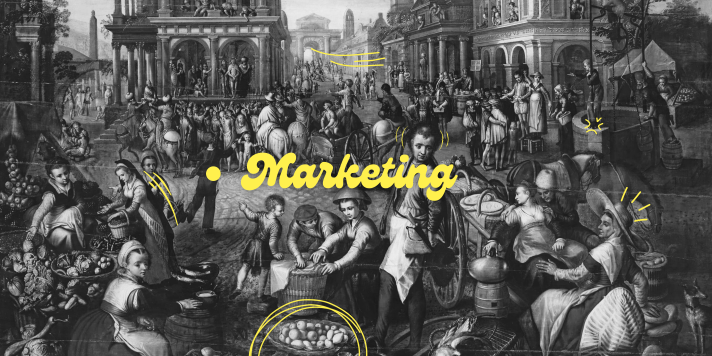When we think of marketing, the image of billboards, TV ads and social media posts, may come to mind. But, what most of us aren’t aware of is that marketing’s roots trace further back than we might think. In this blog, we will delve into the history of Marketing. As we uncover the origins of marketing, we’ll discover the ancient techniques that laid the groundwork for the strategies and tactics employed by marketers today.
From Ancient Trade to Modern Strategy
Marketing can be traced back to Ancient Trade (Pre-18th Century), dating back to civilizations like Greece and Rome. In these early societies, traders engaged in persuasive communication when they offered their goods and services in market squares. However, the term “marketing” as we understand it today did not exist, and the focus was on direct trade and barter.

Industrial Revolution (18th-19th Century):
The Industrial Revolution marked a pivotal moment in the history of marketing. This period was characterized by rapid technological advancements, such as the mechanization of production. With the separation of the production of goods from their consumption, businesses began to recognize the need for effective distribution. At this stage, marketing, although not explicitly labelled as such, was primarily concerned with reducing distribution costs and expanding into new markets. In that sense, its historical roots reveal a strong connection to B2B (Business-to-business) marketing, where efficient distribution and market expansion strategies have always been paramount.
Early 20th Century
The early 20th century saw the emergence of a sales-oriented approach to marketing. Increased competition in a growing marketplace led businesses to focus on selling their products. Advertising, branding, and sales tactics became essential tools for companies as they sought to persuade consumers to choose their offerings over those of competitors. Marketing, while still secondary to production, began to prioritize communication and persuasion.
Marketing Orientated Era
The post-World War II period marked the ascendancy of the marketing orientation. As markets became saturated, companies needed to compete vigorously for customers. Marketers assumed a strategic role within organizations. They conducted comprehensive market research to understand consumer needs and preferences, and they allocated organizational resources strategically to meet these needs. This era also witnessed a growing emphasis on branding, as well as the importance of ensuring that all employees within an organization understood and contributed to marketing activities.
An Ancient Call to Attention
Although marketing and advertisement go hand and hand, marketing is the overall strategy for promoting products or services, encompassing everything from product development to customer relationships. Advertising is a specific tactic within marketing that involves paid messaging to attract attention and prompt specific actions, like making a purchase.
The word “advertisement” stems from the Latin word “advertere,” which means “to turn toward.” In ancient Rome, advertisers used colourful posters and inscriptions to capture the attention of passersby, making this term quite literally a call to attention.
The first-ever written advertisement was discovered in the ruins of Thebes in Egypt dating back to 3000 BC. This advertisement was found on Papyrus and was created by a slaveholder looking for a runaway slave while simultaneously promoting their weaving shop. This early example demonstrates the dual role of advertising in conveying information and promoting products or services.

Pre-Modern Advertising (1700s-1900s)
In the pre-digital era, advertising primarily relied on outdoor and print media. The first newspaper advertisement in the United States was published in 1704. Billboards also came into existence in the early 1800s, providing brands with a new way to convey their value propositions.
Direct Advertising (Late 1800s)
Before the internet, direct advertising was considered expensive, but it gained prominence with Sears’ launch of the first direct mail campaign in 1892. This campaign generated significant orders, encouraging other organizations to allocate more advertising budgets to direct approaches.
Golden Age (1900s-2000s)
The advent of radio and television in the 20th century marked a significant shift in advertising. Radio advertising began in 1922, allowing businesses to directly reach consumers. Television advertising followed in 1941, creating the “Golden Age of Advertising.” Brands started focusing on brand awareness rather than just sales.
Emotionally-driven campaigns became a powerful tool for brands. As markets became increasingly competitive, companies realized that connecting with consumers on an emotional level could shape their preferences. Brands started crafting advertising campaigns that aimed to evoke feelings, create loyalty, and establish a personal connection between consumers and the brand. Iconic slogans and memorable characters became synonymous with their respective brands, illustrating the emotional appeal of branding.
Digital Advertising (2000s-Present)
With the widespread use of the internet, digital advertising took center stage. The first online display ad was created in 1994, and Yahoo pioneered pay-per-click ads, revolutionizing the way advertisers invested their budgets. Social media platforms like Facebook and Google’s advertising services further transformed online advertising.
Google’s AdWords (now Google Ads) and Facebook’s entry into the advertising market brought new levels of targeting and personalization. Platforms like YouTube and Instagram introduced video ads, and social media marketing became a dominant advertising channel.
A Mark of Ownership
The word “branding” has ancient origins, stemming from the Old Norse term “brand,” which initially referred to burning wood. Over time, it evolved to mean marking with a hot iron, often to indicate ownership. The practice of branding, however, predates the word itself. Early humans used symbols drawn in paint and tar to mark livestock in the Stone Age, eventually transitioning to more permanent methods like burning.
Branding expanded beyond livestock to identify goods, with various ancient civilizations using engravings to denote the origin and maker of ceramic products. Artisans in different cultures also embraced branding, with stonecutters, potters, and craftsmen using marks and symbols to distinguish their work.

Industrial Revolution (18th-19th Century):
The Industrial Revolution introduced mass branding as factories sought to differentiate products. Brands like Campbell’s Soup and Coca-Cola emerged. By the late nineteenth century, the Trade Marks Registration Act allowed companies to protect their brands.
20th Century:
During the 20th century, branding underwent a significant transformation. This era saw the emergence of trademark advertising and emotionally-driven campaigns. Brands began to establish more personal connections with consumers.
Trademark advertising became a hallmark of this period. Companies recognized the need to legally protect their brand names and logos to prevent imitation. It meant that consumers could confidently identify and choose products associated with a trusted brand.
2000s – Present:
In the digital age, branding has taken on new dimensions. Traditional advertising methods have given way to storytelling, trust-building, and alignment with social causes. This period has seen a shift towards more authentic and meaningful brand-consumer relationships.
Storytelling has become central to modern branding. Brands recognize the importance of telling compelling narratives that resonate with their target audience. Through storytelling, brands can convey their values, missions, and personalities, creating a more profound and lasting connection with consumers. It’s not just about selling a product but also about sharing a brand’s journey and vision.
Building trust has become a cornerstone of contemporary branding. In an era marked by information overload and consumer scepticism, brands must work diligently to establish and maintain trust. Transparency, authenticity, and reliability are key attributes that consumers look for in brands. Brands that prioritize these qualities often earn loyal followings.
New Insight Gained:
Marketing:
- Definition: Marketing is a comprehensive strategy that encompasses all activities related to promoting and delivering products or services. It includes market research, product development, pricing, distribution, advertising, sales, and customer relationship management..
- Goal: The ultimate goal of marketing is to create customer value, solve problems, and build long-lasting relationships that lead to profitable transactions.
Duration: Marketing is an ongoing, long-term approach to satisfying customer needs and achieving business goals.
Advertising:
- Definition: Advertising is a specific subset of marketing that involves creating and disseminating persuasive messages to a target audience through various channels such as TV, radio, print, digital media, and social media.
- Goal: The primary goal of advertising is to capture attention, create awareness and drive specific actions such as buying a product.
- Duration: Advertising campaigns are typically short-term and designed for specific promotional purposes or events.
Branding:
- Definition: Branding is a strategic approach to creating a distinct and memorable identity for a product, service, or company. It involves consistent messaging, design elements, and customer experience that differentiate the brand in the market.
- Goal: Branding aims to build brand recognition, trust, and loyalty over the long term by creating a strong and consistent brand image.
- Duration: Branding is a long-term strategy that focuses on creating enduring brand equity and recognition.
Conclusion
From ancient market squares in Greece and Rome to the digital age of the 21st century, each era has contributed to the evolution of these critical aspects of commerce.
Marketing has transformed from a focus on direct trade and barter to a comprehensive strategy encompassing market research, product development, pricing, distribution, advertising, sales, and customer relationship management. Its journey has shifted from inward-looking concerns to an outward emphasis on understanding markets and consumers.
Advertising, as a subset of marketing, has evolved from ancient posters and inscriptions to captivating emotionally-driven campaigns. It has transitioned from outdoor and print media to the golden age of radio and television and now finds its zenith in the digital realm. Advertising’s role has always been to capture attention, create awareness, and prompt specific actions, such as purchasing products or services.
Branding, with its roots in marking ownership and goods, has grown from early symbols on livestock to become an enduring strategic approach. It’s about creating distinct and memorable identities, fostering strong emotional connections, and building recognition, trust, and loyalty over the long term.
Our journey through the history of these concepts reveals a profound interconnectedness. Understanding their historical context not only enriches our knowledge but also equips us with valuable insights into their applications in the modern world.


